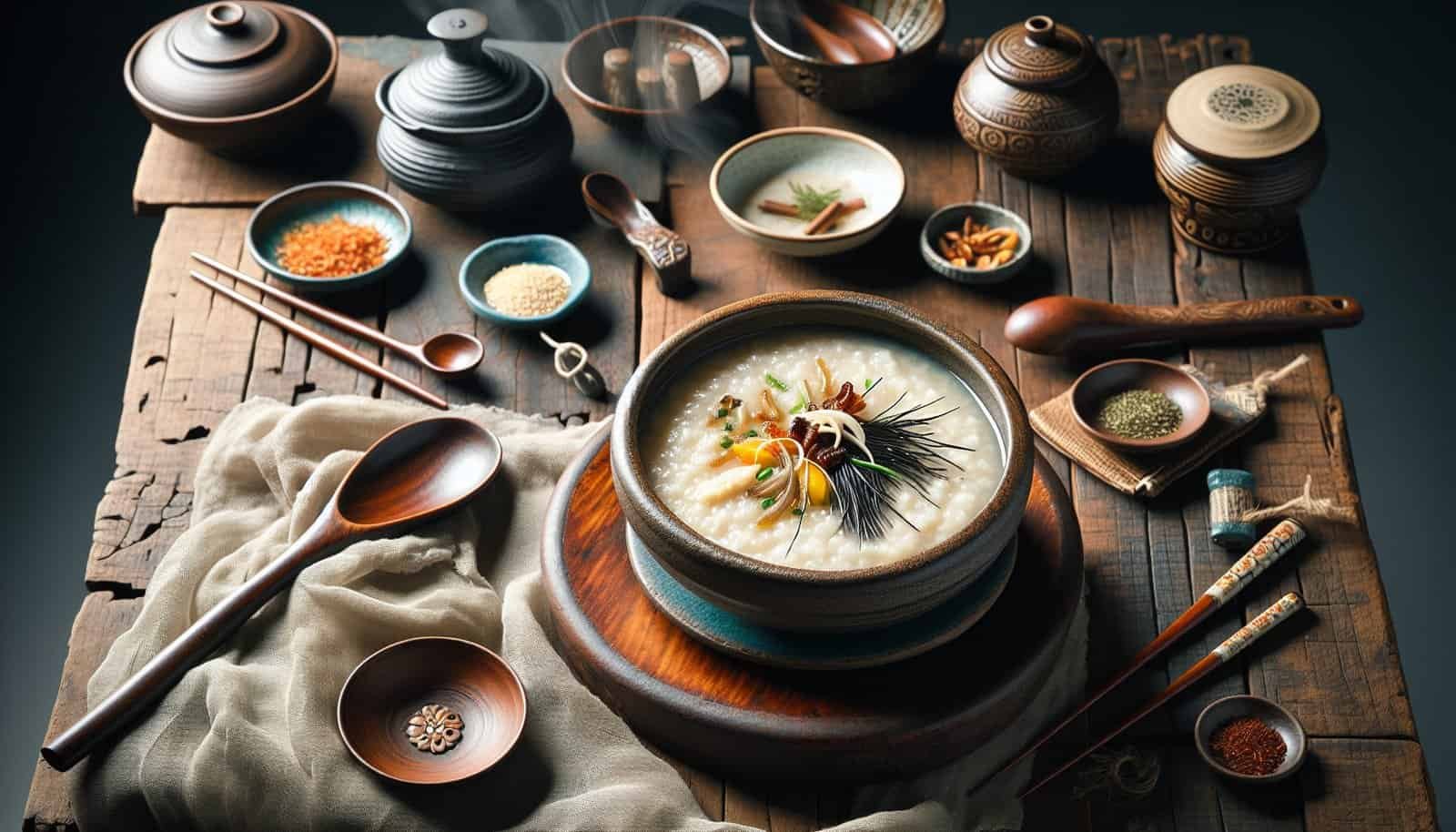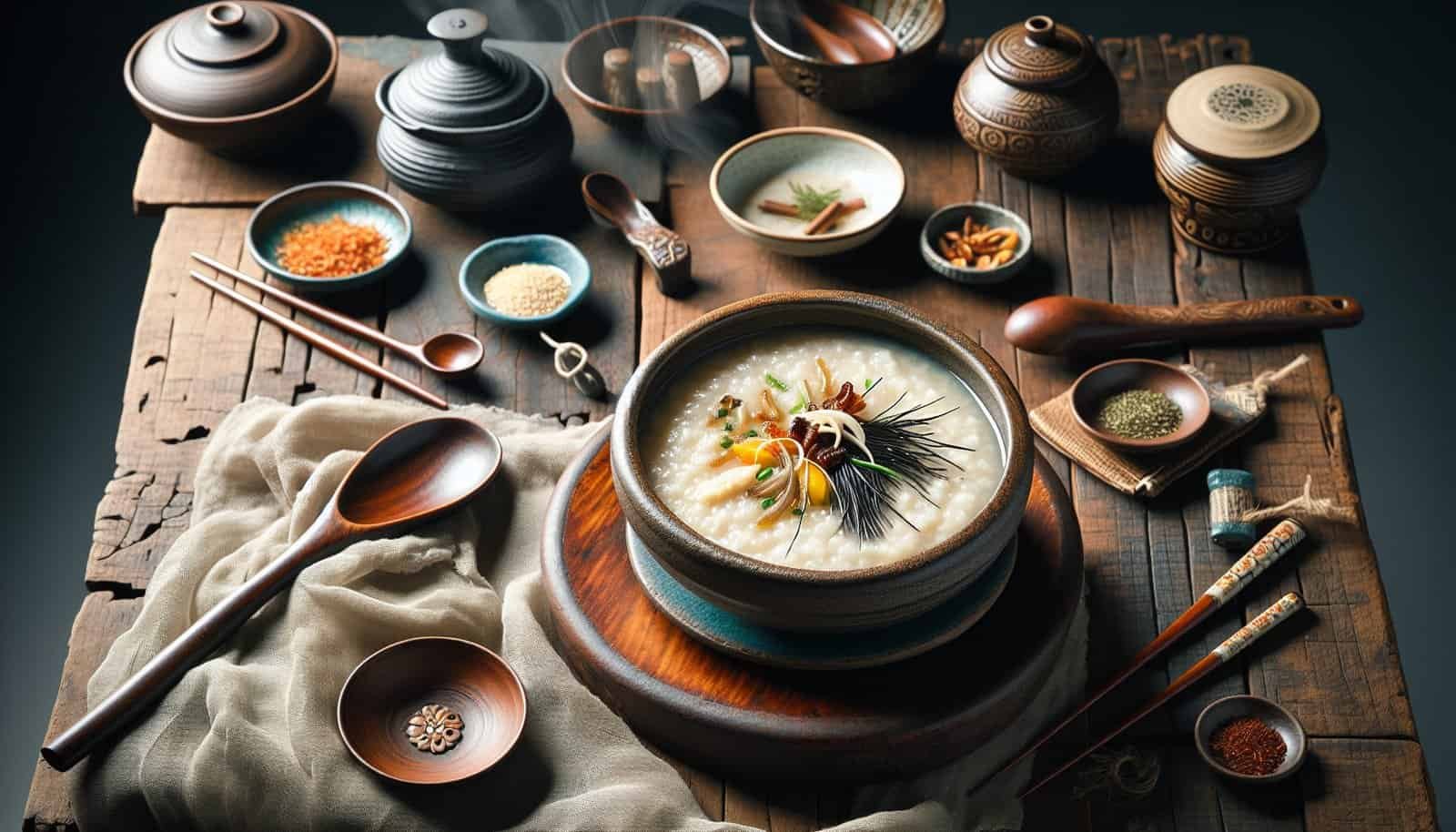If you’re curious about the delicious world of traditional Korean cuisine, then you’re in for a treat! In this article, we will share with you the fascinating process of how traditional Korean porridge, also known as juk, is prepared and enjoyed. From its humble origins to its popularity as a comfort food, you’ll discover the unique ingredients, delicate cooking techniques, and cultural significance that make juk a beloved dish in Korean households. So, grab a bowl and get ready to embark on a culinary adventure filled with warmth, simplicity, and a whole lot of flavor!

Ingredients
Types of rice
Traditional Korean porridge, or juk, is typically made using short-grain rice. However, there are various types of rice that can be used depending on personal preference. Some popular choices include white rice, brown rice, and glutinous rice. Each type of rice adds a unique flavor and texture to the finished dish, allowing you to experiment and find your favorite.
Water
Water is a crucial ingredient when preparing juk. It is used to cook the rice and create the desired consistency of the porridge. The amount of water you need to use may vary depending on the type of rice and the texture you prefer. Generally, a 1:6 ratio of rice to water is a good starting point, but feel free to adjust it according to your preference.
Salt
Salt is used to enhance the flavor of the porridge. A pinch of salt added to the cooking water or sprinkled over the porridge at the end can make a significant difference. You can adjust the amount of salt based on your taste preferences.
Preparation
Washing the rice
Before cooking the rice, it is essential to wash it thoroughly. Place the desired amount of rice in a bowl and rinse it under running water. Use your hands to gently rub the rice to remove any impurities or excess starch. Continue rinsing and rubbing until the water runs clear. This step helps to ensure that the porridge turns out light, fluffy, and free from any unwanted particles.
Soaking the rice
Soaking the rice before cooking can help to improve its texture and reduce the cooking time. After washing the rice, transfer it to a clean bowl and pour enough water to cover the rice completely. Allow the rice to soak for at least 30 minutes, although some types of rice may require longer soaking times. Soaking the rice will allow it to absorb water, resulting in a softer and more evenly cooked porridge.
Cooking the rice
To cook the rice, drain the soaked rice and transfer it to a pot. Add the appropriate amount of water to the pot, taking into consideration the rice-to-water ratio mentioned earlier. Place the pot over medium-high heat and bring the water to a boil. Once boiling, reduce the heat to low and cover the pot with a lid. Allow the rice to simmer for about 30-40 minutes, or until the rice has reached your desired consistency. Stir occasionally to prevent the rice from sticking to the bottom of the pot. The longer you cook the rice, the creamier and thicker the porridge will become.
Variations
Savory juk
Savory juk is a popular variation of traditional Korean porridge. It is often enjoyed as a comforting meal or during times of illness. To make savory juk, you can add various ingredients such as chicken, beef, seafood, vegetables, and even kimchi. The choice of ingredients allows you to create a wide range of flavors and textures in your porridge. Common savory juk varieties include chicken juk, beef juk, seafood juk, pumpkin juk, and mushroom juk.
Sweet juk
Sweet juk, also known as dessert porridge, is a delightful variation that can be enjoyed as a sweet treat or a comforting dessert. Sweet juk is typically made with ingredients like red beans, pumpkin, sweet potatoes, or nuts. These ingredients are cooked with the rice to create a creamy and indulgent porridge. Popular sweet juk varieties include red bean juk, pumpkin juk, black sesame juk, and chestnut juk. Sweet juk is often served warm and can be garnished with toppings like honey or cinnamon for added sweetness.
Toppings
Sesame oil
Sesame oil is a common topping for juk and adds a rich nutty flavor to the porridge. Drizzle a small amount of sesame oil over the porridge before serving to enhance its taste.
Soy sauce
Soy sauce is another popular topping that can be added to juk for an extra savory kick. You can either drizzle soy sauce directly over the porridge or serve it on the side for individual seasoning.
Scallions
Chopped scallions, also known as green onions, can be used as a garnish to add a fresh and vibrant flavor to the porridge. Sprinkle a generous amount of finely chopped scallions over the juk for a burst of freshness.
Fried seaweed
Fried seaweed, also known as gim, can be crumbled and sprinkled over the porridge to add a delightful crunch and a subtle oceanic flavor. It provides a unique texture and enhances the overall taste experience.

Serving
Individual bowls
Juk is traditionally served in individual bowls, allowing each person to enjoy their own portion. This not only adds a personal touch but also ensures that everyone can tailor their porridge to their liking by adding different toppings and seasonings.
Accompaniments
Juk can be enjoyed on its own as a satisfying meal, but it is often accompanied by various side dishes to create a well-rounded dining experience. Popular side dishes include kimchi, pickled vegetables, marinated meats, and Korean-style omelets. These side dishes complement the flavors and textures of the juk, creating a diverse and satisfying meal.
Eating Etiquette
Using a spoon
When enjoying juk, it is customary to use a spoon rather than chopsticks. The spoon allows you to scoop up the porridge easily and enjoy it without any spills or mess. Remember to use a spoon with a flat edge to prevent the rice from slipping off.
Slurping
Slurping is considered acceptable while eating juk in Korean culture. It is believed that slurping enhances the flavors and aroma of the porridge. So, don’t hesitate to slurp and savor each spoonful for a more immersive culinary experience.
Chopsticks
While chopsticks are not commonly used to eat juk, they may be used to enjoy the accompanying side dishes. If you prefer to use chopsticks, feel free to do so when eating the side dishes, and switch to a spoon when enjoying the porridge itself.

Health Benefits
Digestive aid
Juk is known to have soothing properties that can aid digestion. The easily digestible consistency and warm temperature of the porridge make it gentle on the stomach, making it an ideal choice for those who are feeling under the weather or experiencing digestive discomfort.
Hydration
Juk is made with a significant amount of water, which not only contributes to its creamy texture but also helps to keep you hydrated. This can be particularly beneficial during hot summer months or when recovering from an illness.
Nutritional value
While the nutritional content of juk may vary depending on the ingredients used, it generally provides a good source of carbohydrates, protein, vitamins, and minerals. It can be a wholesome and nourishing meal that provides sustenance and energy.
Cultural Significance
Celebratory occasions
Juk holds cultural significance in Korean cuisine and is often associated with celebratory occasions. It is commonly served during traditional festivals, birthdays, and other joyful gatherings. The act of preparing and sharing juk during these events symbolizes unity, health, and prosperity.
Comfort food
Juk is considered the ultimate comfort food in Korean culture. It is often enjoyed during cold winter months or when seeking solace and comfort. The warm and nurturing qualities of juk provide a sense of well-being and emotional satisfaction.
Folk remedies
Throughout history, juk has been used as a folk remedy for various ailments. It is believed to have healing properties and is commonly recommended as a recovery food for those who are sick or weak. Different ingredients and flavors are used to address different health concerns, making juk a versatile dish in traditional Korean medicine.

Regional Juk
Jeonju Juk
Jeonju juk is a regional variation known for its rich and creamy consistency. This type of juk is cooked for a longer period, resulting in a thicker and more flavorful porridge. It often features additional ingredients such as pine nuts or abalone, adding a luxurious touch to the dish.
Heukimjajuk
Heukimjajuk, also known as black sesame porridge, is a specialty from the Jeolla region of Korea. Made from black sesame seeds, this juk has a distinctive dark color and a nutty aroma. It is often enjoyed as a dessert porridge and is believed to have various health benefits, including being a natural source of antioxidants.
Gotaekjuk
Gotaekjuk, or mixed grain porridge, is a nutrient-dense variation of juk. It combines different types of grains such as rice, millet, barley, and beans to create a wholesome and flavorful porridge. Gotaekjuk is known for its earthy taste and is a popular choice among those who prefer a more nutritious option.
Historical Background
Ancient origins
The tradition of making juk dates back to ancient times in Korea. Historical records indicate that juk was consumed as early as the Three Kingdoms period (57 BC–668 AD). It was considered a staple food that provided nourishment and sustenance to the people.
Royal cuisine
During the Joseon Dynasty (1392–1897), juk evolved into a sophisticated dish enjoyed by the royal court. The royal chefs incorporated various ingredients and cooking techniques to create flavorsome and visually appealing porridge. Juk became an important part of the royal cuisine, reflecting the refined taste of the era.
Juk in modern times
Today, juk continues to be beloved by Koreans and is enjoyed by people of all ages. Although traditional juk preparation methods still persist, modern innovations have also influenced the way juk is made and enjoyed. Commercially prepared instant juk mixes are widely available, making it easier for busy individuals to enjoy a comforting bowl of porridge without the lengthy preparation process. However, many still opt for the traditional method, appreciating the time and care involved in creating a homemade bowl of juk.
In conclusion, traditional Korean porridge, or juk, offers a versatile and comforting culinary experience. From choosing the right type of rice to adding a variety of toppings and seasonings, you have the freedom to personalize your juk according to your taste preferences. Whether you prefer savory or sweet variations, juk provides a nutritious and flavorful meal that can be enjoyed on its own or accompanied by side dishes. Its cultural significance, health benefits, and regional variations further add to its charm and appeal. So, why not embark on a culinary journey and try preparing and savoring a bowl of traditional Korean porridge?

